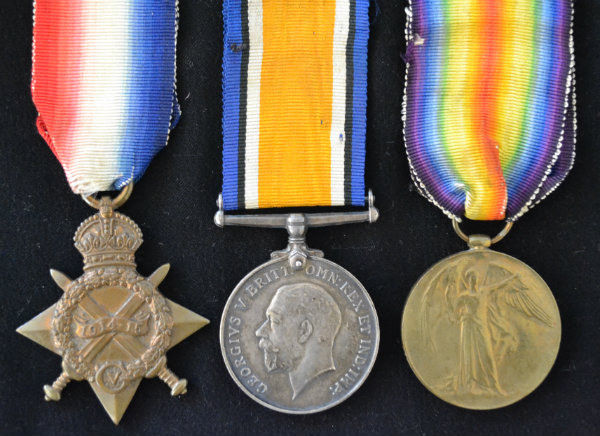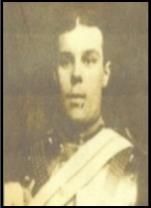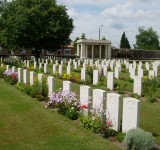Personal Details
Born in Whitchurch in 1892; the eldest son of John and Elizabeth Newbrook of 43 Yardington, Whitchurch.
The 1911 Census details John's occupation as being an assistant butcher and living at 43c Newtown Street, Whitchurch.
John was working as an Engine Cleaner in the railway steam sheds at Crewe before enlisting in the Army in 1914.
Military Details
Regiment : 1st Life Guards, Household Cavalry
Rank : Trooper
Service Number : 3359
Killed in Action; France 26th January 1916 Age 23

The 1914 Star (also known as 'Pip') was authorised under Special Army Order no. 350 in November 1917 and by an Admiralty Fleet Order in 1918, for award to officers and men of the British and Indian Expeditionary Forces who served in France or Belgium between 5 August and midnight of 22–23 November 1914. The former date is the day after Britain's declaration of war against the Central Powers, and the closing date marks the end of the First Battle of Ypres.
The 1914–15 Star (also known as 'Pip') was instituted in December 1918 and was awarded to officers and men of British and Imperial forces who served against the Central European Powers in any theatre of the Great War between 5 August 1914 and 31 December 1915. The period of eligibility was prior to the introduction of the Military Service Act 1916, which instituted conscription in Britain.
The British War Medal (also known as 'Squeak') was a silver or bronze medal awarded to officers and men of the British and Imperial Forces who either entered a theatre of war or entered service overseas between 5th August 1914 and 11th November 1918 inclusive. This was later extended to services in Russia, Siberia and some other areas in 1919 and 1920. Approximately 6.5 million British War Medals were issued. Approximately 6.4 million of these were the silver versions of this medal. Around 110,000 of a bronze version were issued mainly to Chinese, Maltese and Indian Labour Corps. The front (obv or obverse) of the medal depicts the head of George V. The recipient's service number, rank, name and unit was impressed on the rim.
The Allied Victory Medal (also known as 'Wilfred') was issued by each of the allies. It was decided that each of the allies should each issue their own bronze victory medal with a similar design, similar equivalent wording and identical ribbon. The British medal was designed by W. McMillan. The front depicts a winged classical figure representing victory. Approximately 5.7 million victory medals were issued. Interestingly, eligibility for this medal was more restrictive and not everyone who received the British War Medal ('Squeak') also received the Victory Medal ('Wilfred'). However, in general, all recipients of 'Wilfred' also received 'Squeak' and all recipients of The 1914 Star or The 1914/1915 Star (also known as 'Pip') also received both 'Squeak' and 'Wilfred'. The recipient's service number, rank, name and unit was impressed on the rim.
Further Information
Report in the Whitchurch Herald 12th February 1916 on the death of John Newbrook
Letter received by Mr & Mrs Newbrook;
“Your son was killed with others of the regiment in the trenches by a shell which buried him and three other men. I do not think he suffered; his body was carried down by his comrades and buried in a cemetery of soldiers graves. He was one of the best young fellows we had, and we shall feel his loss. I feel how impossible it is to add more, but believe me you have the deepest sympathy of all ranks in my squadron in which your son served”
Captain Hamilton Salter
1st Life Guards
Whitchurch Herald 12th February 1916
If you can provide any further information on John Newbrook please get in touch by leaving a comment below, using our Contact Form or by calling in to Whitchurch Heritage Centre.
Information provided by Terry Evanson Whitchurch, Shropshire and Whitchurch Museum and Archives


